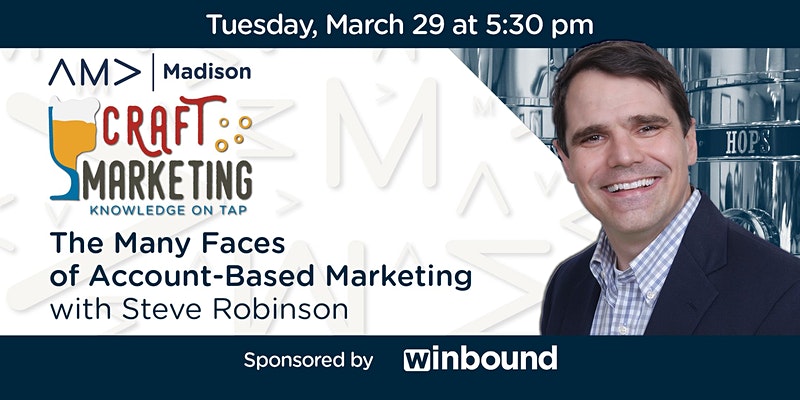Steve Robinson, veteran marketer and the Founder and CEO of Brilliant Metrics, joined AMA Madison’s Craft Marketing on March 29th to explain what Account-Based Marketing is and share three approaches marketers can choose from to find their ideal fit.
Thanks to our sponsor:
What is Account-Based Marketing?
Steve explained that at its core, Account-Based Marketing (ABM) is “treating individual accounts as markets,” which is the definition from ITSMA, the term’s originator.
He went further to explain that ABM flips the traditional marketing funnel, ruling the following priorities (with 1 being the top of the funnel):
- Identify qualified leads
- Expand the list
- Engage, involving both sales and marketing
- Advocate within or outside of the organization
How to Start ABM
Step 1: Identify Your Scale
Steve then launched into the basics behind three scales of ABM:
Strategic ABM
This is the most personalized and high-maintenance version of ABM, requiring many touchpoints. As a result, it works best for 1-3 targets at a time and is best for high-value targets with six-figure or higher deals.
Steve advised that although it depends on your company, industry, and sales team’s selling style, it’s usually not best to begin with strategic ABM. Instead, he recommends starting with one of the other approaches. Only after finding success in one of these approaches should you graduate to strategic ABM. Otherwise, there’s a high risk of burnout.
ABM Lite
This type of ABM customizes content at the industry or application level, rather than intensely tailoring each piece to individual accounts and people. Still, Steve recommends personalization to some degree, even if it’s just based on personas. ABM lite can accommodate 5-20 targets at once, depending on your sales team’s size and selling style.
You may use this approach for mid-value targets with five to six-figure deals. Although this approach involves high-touch tactics, they are repeatable, making them less of a lift.
Programmatic ABM
Although different from the rest, programmatic ABM is still technically ABM. In this approach, you can run 100+ targets at once since your sales team won’t be picking up the phone for every single one. Instead, sales focus on the promising ones with intent. Alternatively, you may use a lower-trained call center. As a result, content isn’t usually customized, and a lot of the marketing is automated with low-touch, highly repeatable tactics.
You may choose this approach for lower value targets, like four-figure deals. It may also be helpful if your prospects draw from a wide variety of industries.
Step 2: Account Selection
Get Your Target List
After identifying your ideal scale, it’s time to determine your ideal customers. Your sales team knows their territories and ideal customers. They likely already have a target list detailing the most profitable clients who are viable long-term customers. This is exactly what you want. After aligning on your ideal customer profile (ICP), ask for their target list.
First-Party Database
In addition to speaking with sales, you’ll want to dig through your CRM database for more valuable information. This is an easy, free step that can help you round out your ideal customer profile.
Third-Party Database Providers
Now that you have your ICP, match it against other databases to generate a target list. This is another easy, valuable step, although it can get expensive. You may consider platforms like ZoomInfo, Leadspace, Seamless.AI, etc.
Step 3: Account Prioritization
In narrowing down the most ideal customers from your lists, Steve presented two different philosophies:
Shaking the Tree
In this philosophy, you’re running every single qualified account through your program. This method clashes with strategic ABM, and it requires significant dedication from your sales team if you’re seeking ABM Lite.
Picking the Ripe Fruit
Here, you identify accounts with intent or that are approaching buying windows. As such, it limits the reach of your ABM program. A lack of intelligence can be a major obstacle, too. However, it can be a great option for targets with specific buying windows.
Timing
When it comes to finding the right timing, lean on your sales team. They know the pressing issues, budget cycles, and contract renewals. This will be especially vital if you’re pursuing strategic ABM or ABM lite.
Third-Party Intent Providers
If you’re willing to pay top dollar, you can utilize third party intent providers like TechTarget, 6Sense, and others. These highly effective tools help with account prioritization by buying data from publications to understand intent signals. Still, given their high price tags, Steve only recommends using them if your ABM program is already successful and you’ve hit all your sales team’s targets.
First-Party Intent Providers
Alternatively, you may consider first-party intent providers. These tools identify the cookied users who have engaged with areas of your site. Many also feature additional exclusive information, like certain companies that use reverse IP technology to identify the prospects on your site, like Lead Forensics or Lead Feeder. You can pair this resource with key web pages or lead scoring to identify intent using first party data.
Steve’s Bonus Tips
Order of Operations
1). “Who?” is the most important question.
You must painstakingly zone in on your ideal customer profile. He also emphasized the importance of nailing your buying committee, including determining your champion, decision maker, and potential blockers.
2). Align on the buyer’s journey.
3). Build content and experiences
Personalize wherever you can and be sure to align on sales and marketing expectations.
4). Deliver and automate only as needed.
Steve’s take on this technology: “Don’t start with tools.” He advises beginning with the content and then fill in the gaps on how you can get to your targets using tools.
See You at Capitol Brewery for April’s Craft Marketing
Craft Marketing invites you to its next live in-person event at Capital Brewery in Middleton at 5:30 PM on April 26th, 2022, where Joey Donovan Guido of Cuppa SEO Web Design will share five strategies to improve your website’s user experience.
About the Venue
Capital Brewery was founded in 1984, and brewed their first batch of beer, a pilsner, in the spring of 1986 and was founded to brew traditional German style lager beer in America. Capital has won over 240 awards at domestic and international competitions. The venue is located at 7734 Terrace Ave. in Middleton, WI.
Register here for the in-person event.

Kara Martin, Content Writer at Naviant, specializes in written B2B content, from case studies to blogs. She transforms complex technical information into compelling, data-driven content.


